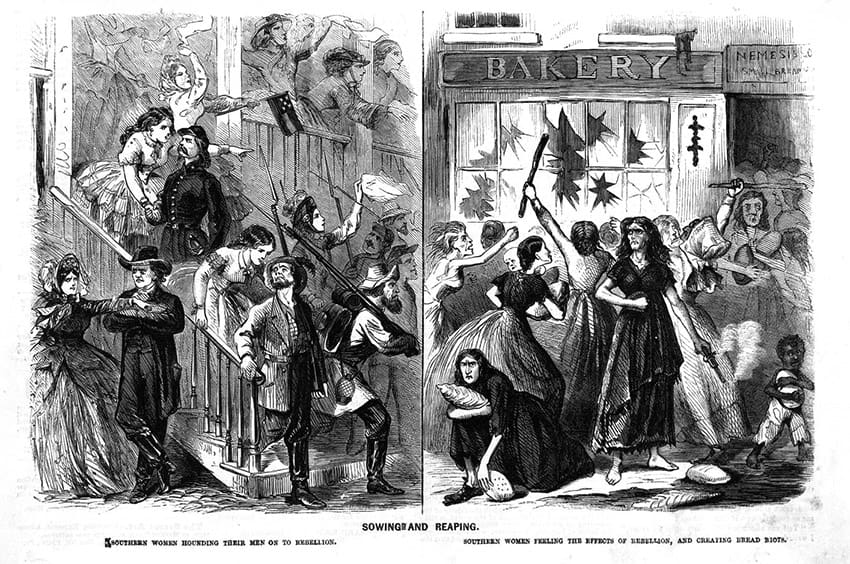March 15, 1863 – April 4, 1863
By Phil Kohn
Phil Kohn can be reached at USCW160@yahoo.com
Off North Carolina, the U.S. Navy and its blockade is foiled once again on March 15, 1863, as the British side-wheel-paddle steamer Britannia slips through the Federal network of ships and makes port at Wilmington to offload its cargo of munitions and other supplies.
Around 2,100 Federal cavalrymen under Brig. Gen. William Averell attempt to cross the Rappahannock River at Kelly’s Ford, Virginia, about 13 miles east of Culpeper and some 25 miles northwest of Fredericksburg, on March 17. They are repulsed after a full day of fighting by Confederate cavalry commanded by Brig. Gen. Fitzhugh Lee, the nephew of Gen. Robert E. Lee.
On March 19, Rear Adm. David Farragut has his two vessels, USS Hartford and USS Albatross, positioned in the Mississippi River just below Vicksburg.
In Tennessee, Confederate troops on March 21 attack a Federal railroad train between Bolivar and Grand Junction. In Mississippi, having failed to take Ft. Pemberton, north of Vicksburg, Grant tries moving 11 gunboats and Maj. Gen. William Sherman’s infantry towards the city through bayous and swamps to the south. The hostile terrain and stiff Confederate resistance stops the Union advance at Steele’s Bayou, Mississippi, on March 21 and, again, on March 24, at Black Bayou. Stymied once again, the Federals begin withdrawing.
On March 22, 1863, Confederates led by Capt. Basil Duke, a physician with Brig. Gen. John Hunt Morgan’s cavalry, capture the Federal garrison at Mt. Sterling, Kentucky.
USS Hartford and USS Albatross, on the Mississippi just south of Vicksburg, bombard Confederate shore batteries at Warrenton, Mississippi, on March 23.
The New Jersey Legislature on March 24 passes a resolution denouncing President Lincoln’s Emancipation Proclamation and suspension of the writ of habeas corpus as unconstitutional and demanding immediate peace negotiations with the Confederacy.
On March 25, Confederate Brig. Gen. Nathan Bedford Forrest, now operating separately from Maj. Gen. Earl Van Dorn, takes some 800 Federals prisoner at Brentwood, Tennessee. Maj. Gen. Ambrose Burnside takes command of the Department of the Ohio, replacing Maj. Gen. Horatio Wright, who joins the Army of the Potomac as a division commander. A Union naval force consisting of two vessels — sloop-of-war USS Lancaster and paddle-steamer ram USS Switzerland — approaches Vicksburg, Mississippi, via Black Bayou. The expedition is ill-fated, however. Bombarded by Confederate batteries ashore, Lancaster is badly damaged and sinks. Switzerland, although also heavily damaged, floats downstream and manages to escape.
Refusing to give up on taking Vicksburg, Mississippi, Maj. Gen. Ulysses Grant on March 29 orders his subordinate Maj. Gen. John McClernand to open a route to the Confederate stronghold from Milliken’s Bend, Louisiana, on the west bank of the Mississippi River, to an area in Mississippi just south of Vicksburg, on the east bank of the river. Acting Rear Adm. David D. Porter is to supply naval support, both for transporting troops and ferrying supplies.
With 11,000 Confederate troops, Maj. Gen. Daniel H. Hill moves against lightly defended Washington, North Carolina, on March 30 and besieges the 1,200-man Federal garrison. Some 400 Confederate raiders from eastern Kentucky enter the Kanawha River Valley and capture Point Pleasant, (West) Virginia. Federal troops take back the town the next day.
On the Mississippi River, U.S. Rear Adm. David Farragut on March 31 successfully leads USS Hartford, USS Switzerland and USS Albatross past Confederate shore batteries at Grand Gulf, Mississippi, south of Vicksburg. At Webber’s Falls, in the Cherokee Nation of Indian Territory, Confederates under leader Stand Watie begin preparing for their Confederate Cherokee Council, scheduled to occur in late April.
About 70 of the 43rd Virginia Cavalry Battalion (“Mosby’s Rangers”), led by Maj. John S. Mosby, on April 1, 1863, rout a detachment of the Federal 1st Vermont Cavalry at Miskel’s Farm, in Loudoun County, northern Virginia, a few miles northwest of Washington, D.C. Of the 150 Federals engaged, 9 are killed, 15 wounded and 82 captured. Mosby’s men suffer 1 dead and 3 wounded. The Southerners take 95 horses.
On April 2, a mob, spurred in part by hunger, rampant food shortages and soaring prices, besieges a bakery wagon in central Richmond, Virginia, demanding bread. Looting and violence quickly expand to other businesses in what becomes known as the Richmond Bread Riot. Quick intervention by President Jefferson Davis — who personally faces down the mob — and calm action by militia forces disperse the rioters without bloodshed.
A Federal attack on April 4 against a Confederate battery at Rodman’s Point, near Washington, North Carolina, is turned back. Lightly defended Washington has been under siege by some 11,000 Confederates under Maj. Gen. Daniel H. Hill since March 30.








